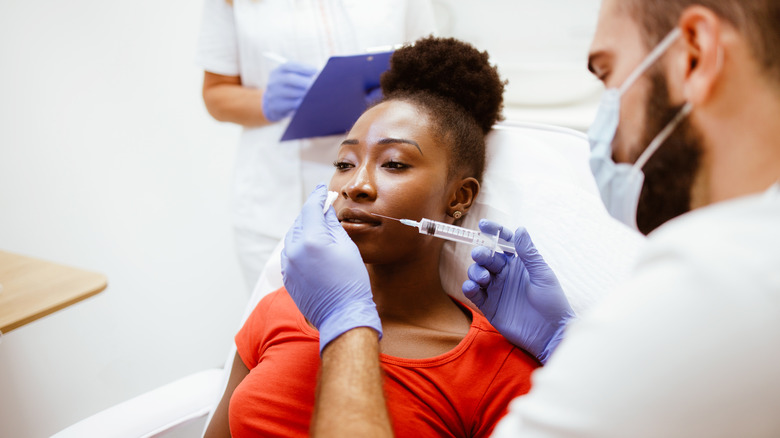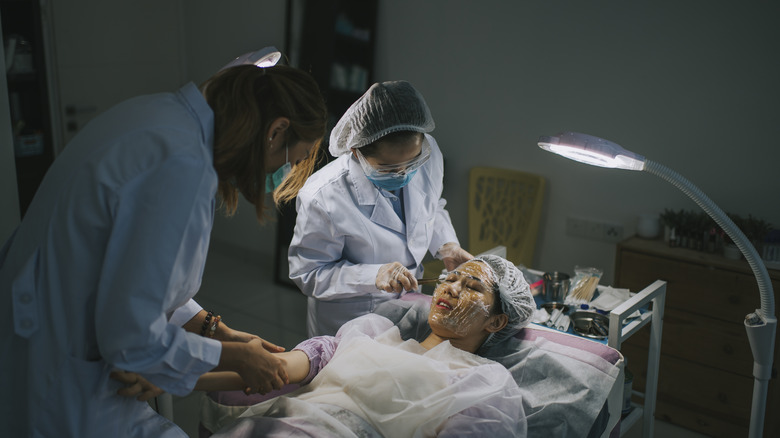Is Filler Migration Something You Really Need To Worry About? Here's The Deal
Imagine looking in the mirror, and discovering — to your horror — that your once-plump lip now sags instead. Worse, you can see and feel an unnatural lump on the upper chin.
That was pop singer JoJo's recent experience, and why she had her lip injection dissolved, as she discussed in a TikTok video. The hashtag #fillermigration on the platform now has over 76 million views, fueling another round of discussions, concerns, and myths around the booming filler market that accounted for $1.2 billion in 2021, according to Transparency Market Research Inc. So, the discussion about filler migration is back at the table: what is it exactly? Why and how does it happen? Should you worry about it?
The name may sound scary, but by the Food and Drug Administration (FDA)'s definition, filler migration is the "movement of filler material from the site of injection." In an interview with Women's Health, Dr. Michael Horn, M.D., a board-certified plastic surgeon said that filler migration can occur anywhere the filler is placed, and "typically occurs in central cheeks, lips, and tear troughs." Migration is also more likely to happen at places that move a lot like the mouth. Fillers are not permanent and migration is a common issue; it can take days or weeks to migrate depending on various factors, but it is preventable and fixable.
How and why does it happen? How can you tell?
Fillers might migrate if: you overfill; injections take place too frequently; the skin of the injection site is too thin; the injected area has too much muscle movement, like the mouth; the type of the filler being used is wrong; or if the layer of skin that got injected is wrong. On top of these factors, pre-existing size, shape, muscle composition, and strength of certain facial features that vary from person to person will also determine if or how long the filler will migrate.
So how can you tell if the filler has migrated? The most straightforward way is to see if there's an unnatural bump or "pronounced fullness" next to the injected area, Dr. Horn told Women's Health. Occasionally, such puffiness could result from swelling caused by the breakdown and absorption of certain types of filler.
This is why finding and consulting with board-certified, skilled injectors prior to and after the surgery is so important. Certified professionals possess a thorough understanding of filler type and skin tissue, and can provide reliable professional advice on what and how much filler to use, and where to best apply it. "Every aesthetic injector has an arsenal of products with different composition properties and viscosities to use, and it is imperative they know what products to use and where to use them," says Dr. Jason Diamond in an interview with Allure.
Should you worry about it? What can you do?
Filler migration can be fixed, and there are two options. The less risky but more time-consuming way is to do nothing: wait for your body to metabolize and break down the substance. Depending on the filler materials, such duration can last between 3 to 18 months. Despite the possibilities of filler entering blood vessels and causing occlusions, filler migration resulting in severe side effects is "incredibly rare," said Dr. Nancy Samolitis to Allure.
Or, you can dissolve it, as singer JoJo did. You will receive the injection of hyaluronidase, a synthetic form of an enzyme that already occurs in your body, which will break down the hyaluronic acid fillers. Hyaluronidase has a low but not zero chance of triggering allergy, so take a test if you can before the surgery. It is worth noting yet another time that the procedure must be carried out by a professional and experienced plastic surgeon who knows exactly where and how much to inject at what frequency, otherwise issues like deficit in original volume may occur. To find a trusted, skilled cosmetic surgeon, make sure he or she has credentials from the American Board of Plastic Surgery or the board of surgeons by country.


